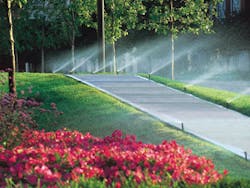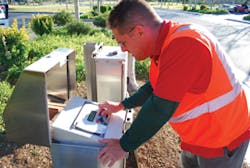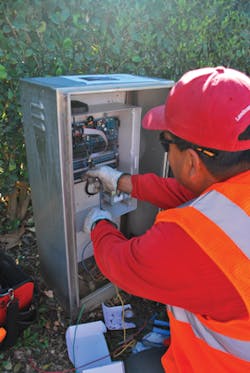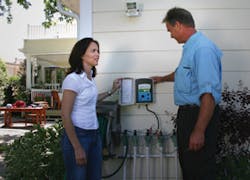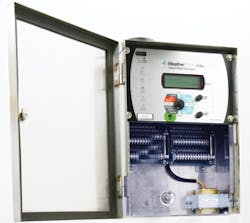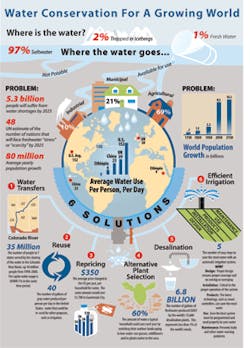Intelligent irrigation products are key to solving issues of higher water prices, while reducing stress on aging infrastructure and facilitating corporate responsibility programs. They also help utilities stretch their budgets. The good news is that manufacturers are introducing products that provide even more efficiency and flexibility for saving water.
Back to School
Soil moisture sensors are contributing significantly to conservation and water savings. Rain Bird, in Azusa, CA, recently introduced their new Integrated Sensor System (ISS). The ISS delivers real-time full central control integration with sensors that transmit soil moisture, salinity, and temperature data. Because it’s integrated with Rain Bird’s central control software, the ISS automatically sets individual station run times based on changes in soil moisture, in real-time. Yet, managers and superintendents define all parameters and retain customized control of their irrigation systems at all times.
Long-term data and computer controls can have a huge impact on complex sites such as a campus.
“Universities are a big market,” says Dave Johnson, Rain Bird’s corporate marketing director, “and we just had a success story at the University of Michigan. It’s a complex area to control, because it’s very spread out and has many different landscaping issues.”
The University reported that Rain Bird’s Maxicom2 Irrigation Central Control System helped to reduce the amount of irrigation water by 68%, saving an estimated $141,000 a year. The system is designed for multi-site commercial or industrial irrigation applications, and can control and monitor hundreds of sites and weather sources from one location, through telephone, cellular modem, radio, modem, Ethernet device server, Wi-Fi, and more. Data from a campus weather station is used to calculate watering rates throughout the campus.
The savings make for a fast return on the project’s original investment of $350,000. Moreover, the project demonstrates a partnership between University of Michigan and the EPA Energy Star Program. Water conservation is a high priority for EPA, and in November 2011 the agency announced it would be awarding the WaterSense label to qualifying watering technology and weather-based irrigation controllers. According to the agency, residential outdoor watering in the US accounts for more than 7 billion gallons of water each day, mainly for landscape irrigation. Efficient controllers could save home and building owners 110 billion gallons of water and roughly $410 million per year on utility bills.
Cutting the Wires
The simplicity of wireless technology will play a major role in savings from upgrading legacy controllers to next generation smart controllers, says Rick Heenan, national commercial sales manager, DIG Corporation, in Vista, CA. Heenan notes that his company’s LEIT-2ET weather-based system doesn’t need wires to communicate with the irrigation system, nor does it need to be wired to a power source. Instead, it’s self powered, using ambient light (solar) power to charge lead-free super capacitors, rather than batteries.
“Solar panels make easy targets for vandalism, and so they need to be fenced off or protected, and positioned for maximum exposure to sunlight,” says Heenan. “Whereas the ambient controller can pretty much go anywhere–underneath trees, bushes, or buildings–and has a much smaller footprint.”
The controller stores weather data from a LEIT weather station every hour during daytime hours. Site information, provided by the LEIT RC2ET handset, combines with the weather station data to calculate the daily local microclimate evapotranspiration (ET) and automatically adjusts the daily irrigation schedule.
Wireless, weather-based data storage systems are popular amongst homeowners associations and landowners with large swathes of landscaped grounds that must be irrigated.
“They have irrigation needs spread out all across their properties, but often don’t have a central controller or weather system,” explains Heenan. “With water conservation being everybody’s concern these days, this is an inexpensive way to convert a system to a smart system.”
Homeowners Associations Hard Hit
Rising water costs hit homeowner associations hard, according to Chris Spain, chief strategy officer, HydroPoint Data Systems, Inc.
“The homeowners association market is huge because their second-highest cost is landscape watering and they typically see a 7 to 10% annual increase,” says Spain. “In Chicago, a 25% increase is expected, so there’s a significant jump in water utility pricing, and that’s a big issue. But it’s just amazing to see how little people understand that outdoor irrigation can represent 40 to 60% of water usage.”
A rate of 40 to 60% might seem low when compared to the Town of Palm Beach, FL, where landscape watering accounted for 85% of consumption, and, overall, water usage was about six times more than the average Florida household. With such high levels of consumption, it’s not surprising that the Dorchester Condominium Association in Palm Beach found room for improvement
The association installed HydroPoint’s WeatherTRAK Smart Water Management Solutions in early 2011, and HydroPoint reports that they realized an immediate cash savings on the first water bill. Over seven months, the community’s water bills dropped 12%. The Dorchester has 26 landscape zones, and WeatherTRAK identifies the zones with programmable parameters, such as plant, soil, and slope type.
ET data is used to adjust irrigation schedules
based on local weather conditions.
The system uses daily ET data to adjust irrigation schedules as local weather conditions change. It also activates a “rain pause” function during hurricane season and allows the Dorchester staff to monitor and manage their smart irrigation controller anytime by using the WeatherTRAK.net Central Internet Management application.
Remote Web-based management systems can make it easy for non-experts to implement a high level of irrigation knowledge. With graphic menus and questions that can lead users along the right track, these systems are taking a lot of the guesswork out of automated irrigation. In the case of ET Water Systems, Novato, CA, it’s as easy as pointing at a picture. Pat McIntyre, CEO at ET Water, explains that the questions and graphics lead users through categories of landscape such as turf, followed by characteristics such as warm or cool season turf, root depth, soil, sun exposure, and irrigation output device, such as spray or rotor.
“After you have set up all the stations and input the data, your controller will call into the cellular network,” explains McIntyre.
At that point, elaborates McIntyre, the server takes all the weather date from an outside resources, and then matches up with, “the parameters of your landscape for the optimal schedule and irrigation.” Reliable, local weather data is provided across the US from a network of over 8,500 local weather stations monitored around the clock.
Giving Landscapers a Hand“One thing we learned from our data was that the industry is really looking for a simpler solution that can be at employed across a wide range of product categories,” says Leezy.
As such, “a simple rain gauge can be either wired or wireless. That’s critical because with smart controllers the sensors need to see the environment,” says Leezy.
Controllers aren’t the only technology that’s getting smarter, easier, and less expensive to install. In September 2011, Toro Inc. of Riverside, CA, helped launch “FreeSprinklerNozzles.com” a Web-based water conservation program that allows customers to learn how to retrofit their existing sprinkler system. Customers receive a voucher good for 25 (residential users), or 100 (commercial users), free Precision Series spray nozzles. The program has distributed over 170,000 of these high efficiency nozzles, and Toro estimates that savings over a five-year span exceed 1.2 billion gallons of water. The program was tested in August 2010 through a partnership of Western Municipal Water District (WMWD), Riverside Public Utilities, and Toro’s Irrigation Business. The program’s success has now led other southern California water providers to join the effort.
Click on photo for larger view online
“We’ve had success with spray nozzle technology and sprayheads are probably the most prevalent type of sprinklers in the United States in terms of total units installed,” says Mike Baron, National Specifications Manager for water management products at Toro.
The Free Sprinkler program recently received a Best Management Practices Award from the California Municipal Utilities Association, and–according to Brent Mecham, industry development director, Irrigation Association–it’s just one of many examples where utilities have promoted the use of intelligent irrigation products.
“The utilities, that are located where water resources are limited, are very much on board with smart controllers, pressure regulated sprinklers, and more sophisticated nozzles,” says Mecham.
Efficiency was a hot subject at the Irrigation Association’s November 2011 trade show says Richard Restuccia, director of Water Management Solutions at ValleyCrest Landscape Companies in Calabasas, CA.
“Efficient products and water conservation were terms that kept coming up in keynotes and general sessions, and it’s much more of a major focus this year than it’s been in the past,” says Restuccia. “I participate in the government affairs committee, and we’re starting to see legislation across the nation. I know that if this industry doesn’t do something quickly, legislators will start enacting laws, and that may not be the way we want to go.
“Look at North Carolina–they just passed a law to reduce consumption of water to 45 gallons a day per person by 2020,” he adds. “That is a real extreme, so as an industry we have to do what’s best for everybody and get busy addressing these issues of water.”
The City of Petaluma Department of Water Resources and Conservation (WRC) is an example of a utility that isn’t waiting around for legislation to address water issues. In July 2011, the WRC announced the launch of Smart Yard, a water conservation program for Petaluma water customers. Smart Yard provides efficient water use technology to homeowners with WeatherTRAK smart irrigation controllers to qualifying water customers at no up-front cost. Participating homeowners pay the balance with zero-interest financing from WRC, which places a fixed fee of $14.95 (for one 12 station controller) on their monthly water bills for five years.
The WRC expects savings from the smart controllers to offset program fees in most cases, and the program provides landscape water use evaluations, plus installation of the controllers, as well as a rain sensors and ongoing customer service. The WRC expects participants to save more than 45 million gallons of water over the next five years.
Corporate Profits Drying Up
Along with water utilities, conservation awareness continues to climb the corporate ladder as a higher priority, especially in light of recent financial news such as the June 2011 news about US apparel chain, The Gap, cutting its full-year profit forecast by 22%, due to drought impact on cotton farmers in Texas. Such events are going to get worse before they get better, according to McKinsey & Co. The global analysts expect a worldwide shortfall between forecasted water demand and available supplies of staggering proportions–40%, by 2030.
Worries about the consequences of water availability have led to tools to indentify water risk and management, such as The Ceres Aqua Gauge: A Framework for 21st Century Water Management Report. The report was developed in collaboration with the World Business Council for Sustainable Development and Irbaris, a sustainability consultancy. Creating a framework for better water risk management, and guidance on developing water strategies are the report’s key goals.
Although a corporation may not be at an immediate risk of a water shortage, they still face the pressure of conservation efforts from groups such as the Carbon Disclosure Project (CDP). The independent not-for-profit organization recently announced an agreement with Deloitte Consulting LLP in the US, to drive the CDP Water Disclosure, an ongoing program to help investors, companies, governments, and other stakeholders by implementing water usage reports as a standard corporate practice globally.
It’s a serious effort that represents serious financial consequences. The CDP has requested information on the risks and opportunities companies face in relation to water on behalf of 354 investors (up from 137 in 2010), with assets of US$43 trillion.
Corporate responsibility and the sustainability movement helps the intelligent irrigation industry, says Brian Vinchesi, president of Irrigation Consulting, Inc., in Pepperell, MA. Moreover, it’s had an impact on some innovative resources for irrigation.
“Rainwater harvesting is really getting popular, and we do a lot on the commercial side, but also the residential side,” says Vinchesi. “Planning for reclamation can be complicated, but it’s certainly doable, and the paybacks can be good, depending on how much rain you have.”
Water reclamation is also a great way for landscape architects to earn points for certification in the US Green Building Council’s LEED (Leadership in Energy and Environmental Design) program. Two points are available for water efficient landscaping, and one point for reducing water use for landscaping by 50% over normal means. A second point is available by eliminating all potable water use or by eliminating irrigation. Private and public entities have embraced LEED certification as a means of demonstrating sustainable practices, and, for certain sectors, sustainability can outweigh other factors, such as cost.
“We see a lot of lead projects on university properties, and they’re not as concerned as the private sector is with their return on investment,” adds Vinchesi.
Scott Thompson, project manager at Irrigation Management Systems (IMS), Portland, OR, agrees that universities tend to show a higher commitment to conservation, but he adds that landscape can often play a role in a corporation’s public image.
“We have some large properties like Nike and large business parks,” says Thompson, “and they put a lot of money into their landscaping and want to look great, yet still conserve water.”
IMS manages Nike’s irrigation system with Rain Bird’s Maxicom2, central control system. It allows the monitoring and irrigation of many different parcels of property or landscaped sites from a single computer-accessed controller. The Nike campus comprises more than 150 acres, but Thompson observes that intelligent irrigation is no longer limited to big grounds with big budgets.
“Smaller commercial areas are finding it affordable to upgrade their controllers,” he says, “and with rising water costs, especially in California, these businesses are much more interested in conserving water.”
Looking Beneath the Surface
Many of those businesses are moving to drip irrigation, says Dave Johnson, Rain Bird. “Drip is one of our fastest growing areas. We used to say you can use drip anywhere but turf, but we introduced our subsurface drip product earlier this year, and it delivers water to the roots so there’s no evaporation and overspray.”
Root intrusion has been an ongoing problem for subsurface irrigation, but the new system uses a copper shield design to protect emitters from root intrusion, without the use of chemical treated filters.
Subsurface systems have many advantages. They are unaffected by wind, evaporation or vandalism, and watering schedules don’t have to avoid an area’s time of usage. For example, irrigation of a sports field occurs below, while athletes play above. Rain Bird reports savings of 30% to 70% less water than overhead sprays, but a smart control system and sensors can boost the savings substantially.
“You can use moisture sensors in conjunction with this subsurface water drip system and get to a point of 100% efficiency,” adds Johnson. “It’s also engineered to regulate pressure so you get the same amount of flow from the beginning of the run to the end.”
Hunter Industries has also introduced a subsurface product line, the Eco-Mat and PLD-ESD. The mat installs under plant material to be irrigated where it becomes fully soaked and then provides a constant water supply directly to the plant’s roots. To prevent root clogging, the fleece keeps water readily available under the plant material, so the plant’s roots do not need to seek out the water source. Hunter sees the Eco-Mat as the solution to locations when overhead irrigation is restricted or prohibited, and high-traffic turf areas like amusement parks, public places, and commercial complexes.
As recent introductions to the industry, subsurface systems have added a new dimension to intelligent irrigation, and they exemplify the overall philosophy defining the industry’s technology offerings: efficiency, simplicity of installation, and lower cost.
“It’s great to see the manufacturers promoting the smart controllers,” says Restuccia. “We have better ways to irrigate and keep our landscapes looking good at much lower water use levels. The other thing that we see is technology getting cheaper as water is getting more expensive. As a result, both are moving in the right direction to push change.”